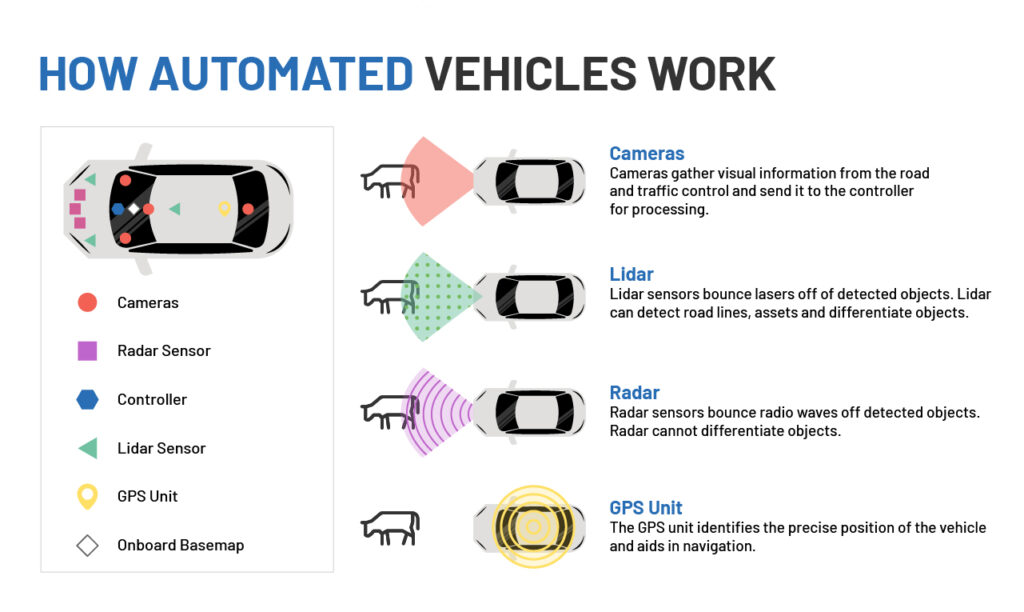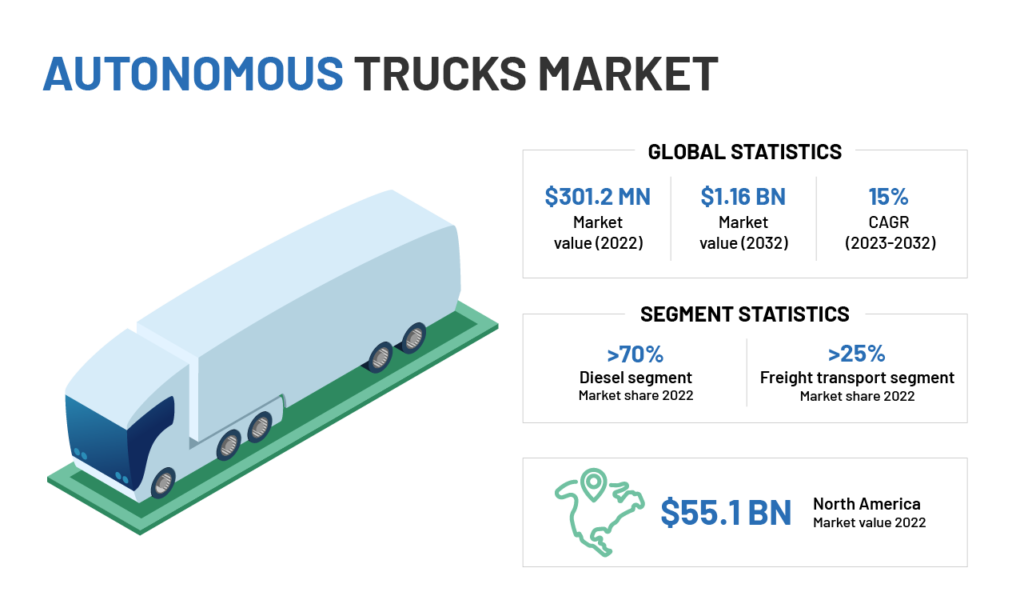
The Impact of Autonomous Vehicles on Logistics
Time to read: 6 minutes
Many recent developments in technologies have greatly affected how the logistics sector operates. Autonomous vehicles are one such technological advancement that can significantly alter logistics dynamics. Thanks to their various technology integrations, these vehicles can be used without a driver. Leading tech companies, including the top automobile manufacturers, have invested significantly in this technology.
Autonomous vehicles (AVs) are anticipated to disrupt business operations, costs, and economic models, whether on land, sea, or air. Logistics and supply chain operations will be significantly impacted, as will the interaction between service providers and customers.
If used widely, many supplementary services and technology will be required to assist autonomous vehicles. These independent “ecosystems” will be similar to the development of traditional vehicles such as cars and planes.
The ability to sense its surroundings enables an autonomous vehicle, also known as a driverless vehicle, to drive itself and carry out essential tasks without the assistance of a human. An autonomous vehicle uses a wholly automated driving system to respond to external conditions like a human driver.

Autonomous Vehicles: Coming to a Road Near You (If They’re Not There Already) (govtech.com)
There are six levels of vehicle automation, and as the levels rise, so does the autonomous car’s degree of operational independence.
Level 0 – The human driver does all of the driving; the car has no control over how it operates.
Level 1 – The car’s advanced driver assistance system (ADAS) can assist the driver with steering, accelerating, and braking.
Level 2 – In some situations, the ADAS can manage steering, accelerating, and braking. However, the human driver is still expected to maintain complete attention to the driving environment during the trip.
Level 3 – The ADS (advanced driving system) can handle every aspect of the driving duty. For safety reasons, the human driver must be able to regain control when the ADS requests it. The driver will also still be responsible for other tasks during a trip.
Level 4 – The vehicle’s ADS can handle all driving duties independently. This is, of course, barring circumstances where driver attention is necessary.
Level 5 – Complete automation. The vehicle’s ADS can carry out all driving tasks in all circumstances, so a human driver is unnecessary. Using 5G technology, vehicles can communicate with one another. It can even transmit traffic signals, signages and even update road conditions.
Adaptive cruise control, also known as ACC, is a feature of vehicle technology in driverless automobiles. This system can automatically change the car’s speed to keep a safe distance from the vehicles in front of it. This feature makes use of data collected by sensors on the car. It enables the autonomous vehicle to carry out actions like braking, increasing or decreasing speeds.
How Autonomous Vehicles Can Benefit Logistics
The final mile delivery, which poses a problem for suppliers and distributors, is often a bottleneck in the delivery process. Delays frequently happen even when the product is close to the final consumer. Businesses are now testing autonomous vehicles that deliver items to consumers without a driver.
Autonomous vehicles can significantly impact distribution, production centers, and logistics by lowering costs and delays. Building distribution hubs on less expensive land near highways and readily available labor has been prevalent. These large centers will need to be near customers due to rapid changes in demands calling for faster delivery times. Businesses choose to be situated adjacent to several cities rather than distributing from one central site. This makes distribution hubs smaller, but rent costs are predicted to rise. Firms can offset this by lowering costs associated with using autonomous vehicles for the last mile of delivery.
There is a clear benefit regarding reduced fuel costs and environmental effects.
Less evident benefits include value-added “as a service” solutions that transfer knowledge and products across the companies in your supply chain.
Increased Safety
Increased safety is one of the critical advantages of autonomous vehicles. Autonomous vehicles can reduce many e problems associated with human errors by doing away with human factors in driving. These include distracted driving, speeding, and driving under the influence of drugs and alcohol. A variety of sensors and cameras are also included in autonomous vehicles. These tools help identify possible dangers and allow the AVs to react faster and more precisely than a human driver. Increased safety can substantially reduce accident rates and insurance costs in the logistics and transportation sectors.
Reduced Costs
Cost savings are another important advantage of autonomous vehicles. Business operations can be made more productive, and labor expenses can be reduced. Errors can be avoided, and work times streamlined when you rely less on human drivers. Autonomous vehicles can lower fuel consumption and maintenance expenses by optimizing routes and driving styles to decrease car wear and tear.
Greater Efficiency
By streamlining routes and speeding up deliveries, autonomous cars can also contribute to the efficiency of logistics and transportation operations. Businesses can decrease the risk of late deliveries and shorten lead times by using real-time data to modify routes and avoid traffic. By giving real-time information on delivery timings and locations, autonomous vehicles can assist in better planning and managing inventory levels.
Three Use Cases of Autonomous Vehicles
The utilization of AVs is fundamentally a digital change. Although the supply chain is no stranger to digital transformation problems, the rate of digital adoption is exponentially growing. For many online merchants, the cost of inaction could be detrimental, especially for late adopters.
As the use of artificial intelligence increases, so does the integration of autonomous vehicle technology in logistics and transportation.
1. Automated Vehicles in the Warehouse
Automated stackers, forklifts, pallet trucks, and small carry rack robots are examples of autonomous vehicles used in warehouses. They train themselves to follow their chosen paths and engage in relevant warehousing activities using machine and deep learning.
Environments like fulfillment and logistics yards benefit greatly from AVs simplifying safety and mapping challenges. However, more sophisticated control capabilities for mechanical activities are necessary due to the exact work that forklifts, tuggers, pickers, and other logistics vehicles do. These AV machines will need to rely on remote human operators to obtain the appropriate level of control. Such a use case lowers the hazards to employees. The added safety also creates unique employment opportunities for people with physical disabilities.
2. Autonomous Truck Platoons
Manufacturers and trucking companies are considering truck platooning for long-haul routes.

Autonomous Truck Market Size & Share | Industry Report, 2032 (gminsights.com)
Platooning allows a convoy of two or more digitally connected trucks to travel closely behind one another. In the use cases studied, a vehicle operated by a driver leads a platoon. The other truck drivers following it monitor the entire system’s performance. However, the objective is to have a driver for the first truck and the subsequent ones being entirely automated and driverless. Using Direct Short-Range Communications, platooning technology integrates adaptive cruise control, forward collision warning, and vehicle-to-vehicle communication.
Platooning allows vehicles to follow one another more closely, which has many advantages. Vehicles in a platoon can travel 40 feet apart, compared to the 324 feet recommended for non-platooning vehicles. Overall road capacity will be improved as a direct result. Along with maintaining a constant speed, truck position lowers drag, improving fuel efficiency.
3. Mobile Delivery Hubs
Delivery vehicles are often delayed due to traffic and the difficulty of parking in urban spaces.
These issues may be resolved using mobile delivery hubs, lessening the necessity of bringing big trucks into crowded, busy cities. On the outskirts of an urban region, the mobile delivery hubs would act as access points. Drivers would drop off packages at the mobile delivery hub and then be transported to their destination by a person, a drone, or a self-driving car.
Automated delivery vehicles can also streamline the actual delivery process. A package carrier would still drive a semi-autonomous vehicle. However, the delivery staff would be able to sort through parcels and drop them off rather than do most of the driving. Not having to park the car, get out, and get back in would save time. The automated vehicle may even follow the delivery staff on pedestrian routes. By doing this, the carrier would have to carry fewer heavy goods and spend less time walking to and from the truck.
The potential of autonomous vehicles in logistics and transportation can be groundbreaking. In the coming years, autonomous vehicles are projected to be widely used in various sectors as technology develops and advances.
ZhenHub has the tools to prepare your eCommerce operations for autonomous vehicle integration. Get closer to your customers with our global network of fulfillment partners. Be equipped with the data that AI will need with our inventory management dashboard. Upgrade your logistics when you sign up at our website.